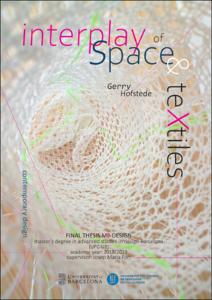Mostra el registre d'ítem simple
Interplay of space & textiles
| dc.contributor | Fort Mir, Josep Maria |
| dc.contributor.author | Hofstede, Gerry |
| dc.date.accessioned | 2019-11-20T19:12:35Z |
| dc.date.available | 2019-11-20T19:12:35Z |
| dc.date.issued | 2019-10-16 |
| dc.identifier.uri | http://hdl.handle.net/2117/172795 |
| dc.description | Qualificació obtinguda: 8 Màster universitari en Disseny -- Contemporary Design |
| dc.description.abstract | This thesis explores the interplay between openwork textile and architectural space. Our research focuses on gaining an understanding of how mesh and netlike textiles can give shape to a spatial realm, regardless of size, and investigates what its unique form giving characteristics and signifiers are in today´s world. The historical exploration gives particular emphasis to examining the role of handmade in crafting spaces by scaling textile techniques. Our analysis of contemporary references finds that amplifying textiles for spatial realms produces strikingly diverse spatial structures that have effects of surprise and awe, while also enhancing cross-cultural familiarity and associations with textiles, such as intimacy, belonging and human connection. We argue that the slow and rhythmic motion of the hand and the powerful dialogue between thinking & making, have special relevance in today´s hectic and stressful world. The second and practice-based part of the thesis concentrates on developing a design proposal that builds on the aforementioned elements and envisions a textile-like space through reimagining an ancient textile technique that we consider as endangered, notably bobbin lacemaking. Through an experimental approach we bring this structurally and visually versatile technique to scale and propose a series of soft spun ´cocoons´ as restorative spaces for people to unwind and disconnect from the never ending demands and distractions of modern life. The design proposal also offers the possibility of hands-on (and slow time) engagement of people with the cocoon spaces as a way to unplug and reboot their energies. |
| dc.language.iso | eng |
| dc.publisher | Universitat Politècnica de Catalunya |
| dc.rights | Attribution-NonCommercial-NoDerivs 3.0 Spain |
| dc.rights.uri | http://creativecommons.org/licenses/by-nc-nd/3.0/es/ |
| dc.subject | Àrees temàtiques de la UPC::Arquitectura::Tipologies d'edificis |
| dc.subject | Àrees temàtiques de la UPC::Arquitectura::Disseny |
| dc.subject.lcsh | Space (Architecture) |
| dc.subject.lcsh | Textile fabrics |
| dc.subject.lcsh | Temporary structures (Building) |
| dc.subject.lcsh | Tensile architecture |
| dc.subject.lcsh | Buildings, Temporary |
| dc.subject.other | Textile |
| dc.subject.other | Space |
| dc.subject.other | Architextile |
| dc.subject.other | Lace |
| dc.subject.other | Craft |
| dc.subject.other | Handmade |
| dc.subject.other | Hands-on |
| dc.title | Interplay of space & textiles |
| dc.type | Master thesis |
| dc.subject.lemac | Arquitectura tèxtil |
| dc.subject.lemac | Espai (Arquitectura) |
| dc.subject.lemac | Teixits i tèxtils |
| dc.subject.lemac | Estructures desmuntables |
| dc.subject.lemac | Estructures atirantades |
| dc.subject.lemac | Construccions temporals |
| dc.subject.lemac | Art tèxtil |
| dc.rights.access | Open Access |
| dc.audience.educationlevel | Màster |
| dc.audience.mediator | Escola Tècnica Superior d'Arquitectura de Barcelona |
| dc.audience.mediator | Escola Superior d'Enginyeries Industrial, Aeroespacial i Audiovisual de Terrassa |
| dc.audience.mediator | Escola Politècnica Superior d'Enginyeria de Vilanova i la Geltrú |
| dc.audience.mediator | Universitat de Barcelona. Facultat de Belles Arts |
| dc.audience.degree | MÀSTER UNIVERSITARI EN ESTUDIS AVANÇATS EN DISSENY-BARCELONA (Pla 2017) |
Fitxers d'aquest items
Aquest ítem apareix a les col·leccions següents
-
Màster universitari en Estudis Avançats en Disseny-Barcelona (MBDesign) [174]
Titulació interuniversitària UPC-UB


